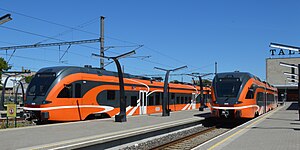Tallinn Baltic Station
Tallinn Baltic Station | |
|---|---|
| Balti jaam | |
 | |
| Location | Toompuiestee 37, 10133 Tallinn Estonia |
| Coordinates | 59°26′23.82″N 24°44′13.74″E / 59.4399500°N 24.7371500°ECoordinates: 59°26′23.82″N 24°44′13.74″E / 59.4399500°N 24.7371500°E |
| Owned by | Go Group |
| Operated by | Go Group |
| Line(s) | Elron Tallinn-Tartu-Valga Elron Tallinn-Tartu-Koidula Elron Tallinn-Narva Elron Tallinn-Viljandi Elron Tallinn-Aegviidu Elron Tallinn-Turba/Paldiski Russian Railways Tallinn–Moscow |
| Platforms | 7 |
| Tracks | 12 |
| Connections | Bus 21 21B 41 41B 43 59 Trolleybus 4 5 Tram 1 2 |
| Construction | |
| Structure type | at-grade |
| History | |
| Opened | 1870 |
| Rebuilt | 1960-1966 |
| Electrified | 1924 3 kV DC OHLE |
| Passengers | |
| 13,500,000[1] | 36, 986 |
| Wikimedia Commons has media related to Balti jaam. |
Baltic Station (Estonian: Balti jaam) is the main railway station in Tallinn, Estonia. All local commuter, long-distance and international trains depart from the station.
The station has seven platforms, of which two are situated apart from the rest and serve either international Tallinn–Moscow and Tallinn–Saint Petersburg routes performed by GoRail, or Elron's long-distance route to Viljandi. Platforms closer to the station building are mostly used by the commuter trains or long-distance routes to Tartu or Narva.
The Balti jaam stands close to a market called Jaama turg ("station market").
History[]
Balti jaam is situated northwest of the historic centre (Old town) of Tallinn. The first railway station in Tallinn was built at the end of the 1860s as part of a 400 km (250 mi) long St. Petersburg-Tallinn-Paldiski railway line. The first main building was completed in 1870. It was a 2-story building constructed from limestone with tower like extrusions. During World War II in 1941, the station building was set on fire by the Red Army and shortly after the war in 1945, it was partly renovated. During 1960–1966, the station was completely reconstructed. Since the 1990s, the commuter trains 20x20m waiting pavilion has been used as a market. In 2005, the station building was completely renewed and Hotel Shnelli and the headquarters of Estonian Railways (Eesti Raudtee) were completed nearby.
Gallery[]

Exterior Platforms 
Interior in 2009 
Old station (1910)

Trolleybus no. 4 
Station Market 
Moscow train 
Locomotive L-2317
See also[]
References[]
- Tallinn Encyclopedia (part I), 2004. Page 30. ISBN 9985-70-168-2.
External links[]
| Next station | |
| Westbound to Paldiski/Turba | |
| Lilleküla | |
| Southbound to Viljandi | |
| | |
| Eastbound to Tartu/Narva | |
| |
- Railway stations in Estonia
- Transport in Tallinn
- Railway stations opened in 1870
- 1870s establishments in Estonia
- Buildings and structures in Tallinn








